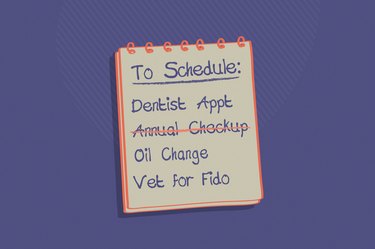What's in a person's wallet or bank account shouldn't affect the quality or quantity of health care they receive. And yet anyone who has ever debated between ponying up a $50 copay or paying for groceries, rent or other necessities knows that's not the case. Sometimes, health care is out of reach financially.
Sliding fee scales aim to introduce equity to health care decisions, by offering a discounted rate. "The advantage of using a sliding fee scale is that health care becomes a lot more affordable because how much you need to pay for each procedure becomes relative to your income," says David Chen, DDS, a dentist in Long Island City, New York.
Video of the Day
Video of the Day
Here's what you need to know about the sliding fee scale and how it might help you.
What Is a Sliding Fee Scale?
Sliding fee scales are typically determined by income. They aim to cut the cost of health care services for people who meet certain income requirements, explains Christa Holmes, the practice manager at Cornerstone Care Community Health Center of Washington.
Essentially, it allows health care providers to "reduce your out-of-pocket expenses for your services, based upon your household's income," Holmes says.
Sliding fee scales are required at Federally Qualified Health Centers (FQHC), which get federal funding and provide health care to underserved areas or populations, according to the U.S. Centers for Medicare & Medicaid Services.
But FQHCs aren't the only health institutions to offer a sliding scale — other clinics, hospitals and private practices may offer sliding fee scales as well. (More on that in a moment.)
How Sliding Fee Scales Work
Eligibility
Your eligibility for the sliding fee scale at a FQHC is determined by two things: the size of your family and your income level. To qualify, your income needs to be at or below 200 percent of the Federal Poverty Guidelines, Holmes explains.
For D.C. and all states aside from Hawai'i and Alaska, the poverty guideline for an individual in 2024 is $15,060, according to the Office of the Assistant Secretary for Planning and Evaluation (ASPE). For a family of four, the income level is $31,200, per ASPE. So, 200 percent of the federal poverty guidelines for a single person is $30,120, and for a family of four, it's $62,400.
Clinics typically request proof of income, Holmes says. "That can be in the form of a pay stub, most recent income tax return or W-2 or proof of any form of income not reportable on a tax return," she says. You'll need to include information for yourself and anyone else in your household, because the guidelines vary accordingly.
You can ask the health care organization or provider for a list of documents required for proof of income.
Do You Need Health Insurance?
Put simply: No, not at a FQHC.
"The sliding fee scale can be offered to patients regardless of their insurance status," says Elizabeth Workinger, controller for Family First Health, a FQHC in Pennsylvania. "If you qualify for the program and have insurance, there is a possibility it can help with out-of-pocket costs," she says.
Outside of FQHCs, health insurance requirements may vary.
Fees Vary From One Clinic to Another
If you're going to a FQHC, it must follow the Federal Poverty Guidelines to determine if you're qualified for a sliding fee scale, Workinger says. But, "each health center can establish their own fees," she notes. Consider comparing the fees at multiple health care providers to find the best deal.
Are Sliding Fee Scales Available Elsewhere?
It's not only FQHCs that offer sliding fees. Other health clinics, hospitals and private practitioners may offer them as well.
For instance, the Chicago Women's Health Clinic (CWHC), which offers service to women, transgender individuals and youth, has a sliding scale based on income and household size, and it doesn't require any documentation or proof of income to access the sliding scale.
At Memorial Sloan Kettering Cancer Center (MSKCC), there's a financial assistance program available "for people with household incomes up to 5 times the federal poverty level who cannot pay for their medical care." If you're eligible for this program, it can lead to lowered fees (like a sliding scale) or the balance being paid after you pay the amount you can afford, per MSKCC.
There's a sliding fee program available at Northwell Health solely for uninsured patients. And at Cedars-Sinai, you can receive medical care without any charge if your income is at or below 400 percent of the federal poverty level, or get a discounted rate if your income is between 401 and 600 percent of the federal poverty level.
And some — but not all — private practices may offer a sliding fee scale.
As the owner and founder of Nutrethos, a nutrition counseling practice, Carlos Fragoso, RD, CDN, doesn't accept insurance, explaining "as a single-member private practice it is extremely difficult to become in-network with insurance companies" and noting that "navigating the world of insurance billing is like learning a new language."
Instead, his clients pay out of pocket. Insured patients with out-of-network benefits sometimes are reimbursed for these payments by their insurance.
"For those clients who do not have out-of-network benefits and may not have the financial means to pay weekly to see me, I offer a sliding scale which is approximately a 10 to 35 percent discount off my usual rate, depending on their needs," Fragoso says.
Needs are determined based on income and financial obligations, and through "an open and honest discussion," he says. "I do not ask to see financial statements, I think that is too invasive."
For therapists, a sliding fee scale is quite common, but not required, says Stephanie Barca, LMSW, of Benjamin Holmes Counseling, in Nashville, Tennessee. That means "there is no uniform process," she says. "Some therapists choose to have prospective clients fill out a form asking for specific financials. Others may ask what the individual is comfortable paying and discuss how they got to that amount."
Offering a discounted rate can be easier for private practitioners, Barca says, echoing Fragoso. But not all practices offer this. Dr. Chen doesn't offer a sliding fee schedule at his dental office. Some private practices can be reluctant to do so, he believes, because it can require requesting pay stubs or tax returns. "Dentistry is pretty personal, but that's a little too personal in my opinion," Dr. Chen says.
Setting up a sliding fee scale is a challenging task. You either take people at their word (as Fragoso does) or require paperwork, which means an administrative burden.
There's another reason private practitioners may hold off on establishing a sliding scale: They need to cover their costs and earn a living. "I usually reserve 20 percent of my spots for clients who require a sliding scale," Fragoso says. He operates with a sense of how much he needs to take home each month. "If I take on more clients one month, I can offer more sliding scale spots," he says.
Other Ways to Reduce Your Costs
A sliding fee scale is not the only way to keep your health care costs down.
Working with students or trainees (who are under supervision from licensed practitioners) can deliver reduced costs. If you’re in need of dental care, for instance, a local dental school may provide free or low-cost care, per the U.S. Department of Health and Human Services.
“All of the dental clinics and post-graduate residency programs that I worked at were all based on a sliding fee scale," Dr. Chen says. At the time, one hospital was charging $200 for dental implants, he recalls, when dental implants can typically cost between $2,000 and $4,000, according to the University of Texas Southwestern Medical Center.
Similarly, clinics, private practices and universities may offer lower-cost rates for therapy with trainees.
Tips for Using a Sliding Scale
Find a Provider
One smart starting place: Look for a FQHC located near you, Workinger says. Visit findahealthcenter.hrsa.gov to find locations, she suggests.
You can search online for providers or clinics using keywords like "sliding scale" or "financial assistance" and the type of doctor or health care you need. You can also search major hospitals located nearby.
For therapists, Psychology Today and Good Therapy offer directories with a filter for therapists offering a sliding scale, Barca says. Keep in mind that not all therapists will advertise their negotiating ability.
Fees Can Slide, but Your Level of Care Shouldn't
If you’re seeing a provider who uses a sliding fee scale, it should not affect the quality of your care. “The therapist's ethical obligations remain the same, and the relationship between the client and the therapist is no different otherwise,” Barca says.
Be Prepared for Paperwork and Conversations
Expect that many health care offices will want you to fill out some paperwork, and bring along some proof of income. (Again, it won't be required by all health care providers, but FQHCs will need documentation.)
It can help to call before your appointment, so you can be clear on if you're covered, and what fee you'll owe prior to receiving care. You can also check on the clinic's website to understand what information you'll need to provide and review the application.
For practitioners who aren't part of a FQHC, there are a lot of ways to handle the sliding fee scale. Some, like Fragoso, may reserve a set amount of appointments for patients. "Some therapists choose to have prospective clients fill out a form asking for specific financials. Others may ask what the individual is comfortable paying and discuss how they got to that amount," Barca says.
You Can Always Ask
That classic saying is true: If you don't ask, you don't get.
"The best way to ask a provider about a sliding scale fee is to just be straightforward with them," Fragoso says. You can tell the health care provider that you'd love to work with them, but aren't able to pay their standard rate, he says. "And then simply ask: 'Do you offer a sliding scale?'" he suggests.
It can help to have a sense of what you can afford beforehand, Barca says. "Be ready to share information honestly and authentically," she says. "That feels vulnerable, but know that it is vulnerable for the therapist to engage in the discussion, too. Our practice is our livelihood," Barca notes.
It's possible the health care provider will say a sliding fee scale is not an option. "While this may seem like a rejection, it is not personal. It is a business decision often based on factors out of both parties' control," Barca says.
Consider a few potential follow-up ideas if a sliding fee scale isn't possible:
- Inquire about a waitlist: Some providers may only reserve a few slots for patients who need a sliding scale, Fragoso says. If that's the case, ask if there's a waitlist you can join.
- Ask for a referral: Whether you're looking to see an MD, RD, PhD or any other specialist, you can feel confident that the health care practitioner — or the front desk or financial department — may have more connections than you in the field. They might be able to offer some suggestions for where you can receive lower-cost care or access a sliding scale. "If a provider isn't able to offer a sliding scale, ask if they can refer you to another provider who can," Fragoso says.
- See them less frequently: In some cases, it may be an option to see the provider every other week to ease the burden of the cost, Fragoso says. You could also ask about financing options or if the provider has any suggestions for other ways to lower the fee.
- U.S. Centers for Medicare & Medicaid Services: "Federally Qualified Health Center (FQHC)"
- Office of the Assistant Secretary for Planning and Evaluation: "HHS Poverty Guidelines for 2023"
- Chicago Women's Health Clinic: " Paying for Services"
- Memorial Sloan Kettering Cancer Center: "Financial Assistance Program"
- Northwell Health: "About the sliding fee scale program"
- Ceders-Sinai: "Financial Assistance"
- U.S. Department of Health and Human Services: "Where can I find low-cost dental care?"
- University of Texas Southwestern Medical Center: "Dental implants: A 5-step plan to restoring your teeth"
- Psychology Today: "Find a Therapist"
- Good Therapy
Is this an emergency? If you are experiencing serious medical symptoms, please see the National Library of Medicine’s list of signs you need emergency medical attention or call 911.


